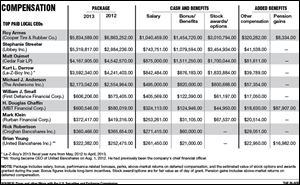
Regional CEOs get their pay but salary is just a piece of the total compensation package
5/25/2014
BLADE ILLUSTRATION/ TOM FISHER

George Chapman, the former chief executive officer of Health Care REIT Inc., was the highest-paid executive in the area last year — at least on paper.
Under the U.S. Securities and Exchange Commission’s guidelines, Mr. Chapman’s total compensation last year was reported at $19.8 million. However, $8 million of that represents stock awards he could receive under the firm’s new long-term incentive program adopted last year. Though the compensation was reported in 2013, he won’t be eligible to receive anything until after 2015.
Though he retired last month, he has been retained as a senior adviser. As long has he remains in that position, he will be eligible for the long-term incentive program.
He could get more than $8 million. He could get less. He could get nothing. That uncertainty is representative of most CEO’s pay packages.
RELATED: Shareholders get their say on executive pay
For the CEOs of most large companies, base salary is only a small portion of their total compensation for the year. The big money — relatively speaking — typically comes through bonuses and stock awards, some of which are tied to future performance or may not be redeemable for years.
Imperfect as they are, the packages reported to the SEC are the standard gauge of how top executives are paid for their duties.
The Blade reviewed SEC filings for 15 publicly traded companies in the Toledo area to compile compensation data for their CEOs and other senior executives.
These executives were paid at least $2 million in 2013, according to the U.S. Securities and Exchange Commission.
The first number is salary and the second is total compensation.
DANA HOLDING CORP.
■ Aziz Aghili, president off-highway technologies, $457,500; $3,243,610
■ Mark Wallace, executive vice president and president of on-highway driveline technologies, $561,750; $2,586,015
■ William Quigley III, executive vice president and chief financial officer, $611,250; $2,369,634
■ Jeffrey Bowen, chief administrative officer, $472,500; $2,040,408
HEALTHCARE REIT INC.
■ Scott Brinker, executive vice presidents, investments, $444,960; $4,545,118
■ Scott Estes, executive vice president and chief financial officer, $444,960; $4,398,362
■ Charles Herman, Jr., executive vice president and chief investment officer, $444,960; $4,398,077
■ Jeffrey Miller, executive vice president, operations, and general counsel, $444,960; $4,384,745
MARATHON PETROLEUM CORP.
■ Garry Peiffer, executive vice president, corporate planning and investor and government relations, $600,000; $5,709,089 (Mr. Peiffer also received total compensation of $1,155,100 for his role as president of MPLX LP.)
■ Donald Templin, senior vice president and chief financial officer, $631,250; $3,764,745 (Mr. Templin also received total compensation of $840,419 for his role as vice president and chief financial officer of MPLX LP.)
■ Anthony Kenney, president of Speedway LLC, $543,750; $2,845,421
■ Richard Bedell, senior vice president, refining, $537,500; $2,614,272
OWENS CORNING
■ Charles Dana, vice president, president building materials group, $596,667; $2,669,700
■ Arnaud Genis, vice president, president composite solutions business, $541,667; $2,443,771
■ Michael McMurray, senior vice president and chief financial officer, $475,000; $2,167,353
OWENS-ILLINOIS INC.
■ Erik Bouts, president O-I Europe, $600,909; $2,339,275
■ Arnaud De Weert, president, O-I North America, $611,737; $2,256,823
The figures include salary and bonuses, estimated value of stock awards and options, performance-based incentives, values of perquisites such as cars and corporate travel, and company contributions to executives’ pensions and retirement plans.
In general, the larger the company, the higher the pay.
The four executives behind Mr. Chapman on the list run Fortune 500 companies.
But the man who runs the area’s other Fortune 500 company is further down the list.
Michael Anderson, the CEO of The Andersons Inc., was 10th in total compensation at $2.2 million. His company ranked No. 472 on the Fortune list and was the region’s fourth-largest company by revenue last year.

Gary Heminger’s total pay fell by a fourth in 2013, but the top man at Marathon Petroleum Corp. still was easily the second highest-compensated executive among the area’s publicly traded companies last year.
Mr. Heminger’s total compensation in 2013 was $15.5 million. He was paid $12.8 million as president and chief executive officer of Marathon was and an additional $2.7 million as chief executive officer of MLPX LP, a pipeline subsidiary that Marathon spun off in 2012.
Marathon, based in Findlay, is by far the region’s largest publicly traded company, with 2013 revenues of $100 billion. The refining giant ranked 33rd on the 2013 Forbes 500 list.
High as Mr. Heminger’s pay was, it was nearly 25 percent less than the two companies paid him in 2012. Buoyed by an $8 million gain in his pension value, Mr. Heminger’s total reported compensation in 2012 was $20.4 million. He had no pension gain last year.
Dana Holding Corp. CEO Roger Wood was third, with a $9 million compensation package. Owens-Illinois Inc.’s Albert Stroucken and Owens Corning’s Mike Thaman rounded out the top five.
Nine of the 15 CEOs had total compensation packages worth more than $3.5 million. Five had base salaries of at least $1 million, up from four in 2012.
Of the 15, only one — Mr. Anderson — had his salary reduced in 2013. His cut was both temporary and voluntary.
Anticipating a challenging year, The Andersons delayed salary increases for company officers and senior managers for a year. Incentive-plan payments were delayed seven months.
Mr. Anderson, who has been the company’s CEO since 1999, initiated a temporary 10 percent reduction in his salary, with the stipulation that if the company met or exceeded its 2013 plan, he would be reimbursed the difference early this year.
The company met those benchmarks, and Mr. Anderson’s full salary since has been restored.
A spokesman for The Andersons said last week the company doesn’t comment on executive compensation.
Mr. Stroucken’s salary was unchanged.
The biggest percentage gain in 2013 was that of Stephanie Streeter, Libbey Inc.’s chief executive officer since mid 2011.
Ms. Streeter’s total compensation package grew to $5.3 million last year, a 78 percent increase from 2012. Her base salary increased by 3.5 percent to $743,751, but the biggest reason for the jump was a special retention award valued at $2.5 million.
In Libbey’s annual report filed with the SEC, the company said its nonmanagement directors had on multiple occasions “discussed the fact that Ms. Streeter is a highly attractive candidate for CEO positions with companies that are much larger than Libbey.”

Believing her to be the best person to lead Libbey to sustained, profitable growth, the directors charged the company’s compensation committee with developing a retention award that would keep Ms. Streeter with the company through the end of 2018.
The award, presented in December, doesn't vest until Dec. 31, 2018, meaning Ms. Streeter can’t access any of the money unless she stays through the desired time. Still, under SEC regulations, it is counted as part of last year’s compensation.
Though additional perks aren't as prevalent and generous as they once were, some executives still enjoy things such as personal use of a corporate jet, club memberships, or an annual cash allowance.
Mr. Heminger and Mr. Stroucken are encouraged to use their company’s corporate aircraft for personal travel, partially for security reasons. Mr. Heminger’s use last year was valued at $40,000. Mr. Stroucken’s use was valued at $87,000.
Dana grants its CEO a $50,000 cash allowance, in lieu of a car allowance or club memberships.
Health Care REIT paid almost $38,000 for Mr. Chapman’s membership fees at three country/dining clubs.
Mr. Chapman said in April he was stepping down effective immediately as Health Care REIT’s chief executive to focus more time on his family, civic pursuits, and to deal with an unspecified health concern which he said was not life-threatening.
He was one of the area’s longest-tenured CEOs, having taken over at Health Care REIT in 1996. Over that period, the company grew from $541 million worth of real estate investments to $21.7 billion of real estate investments.
Contact Tyrel Linkhorn at tlinkhorn@theblade.com or 419-724-6134 or on Twitter @BladeAutoWriter.